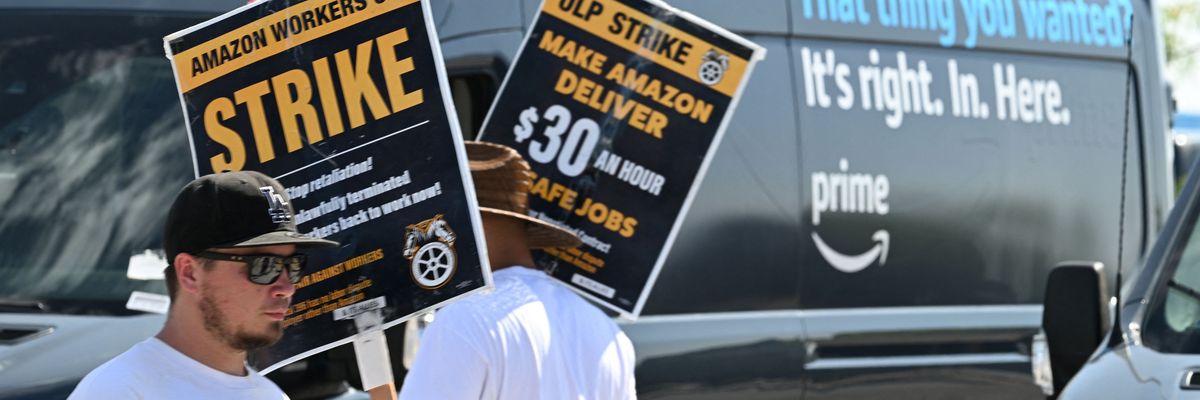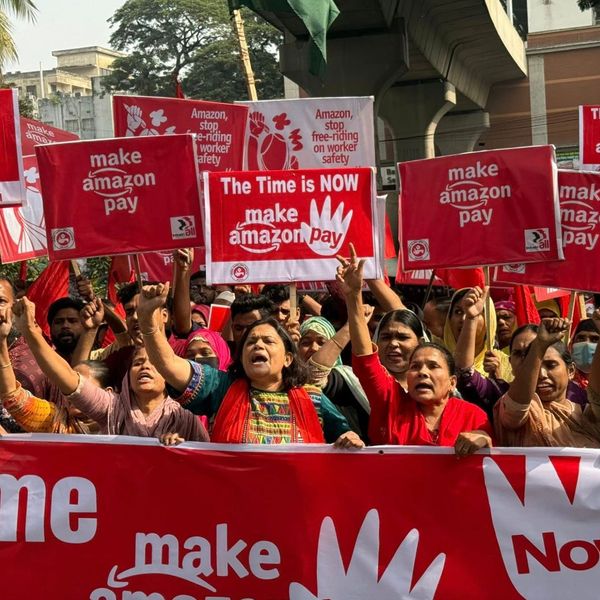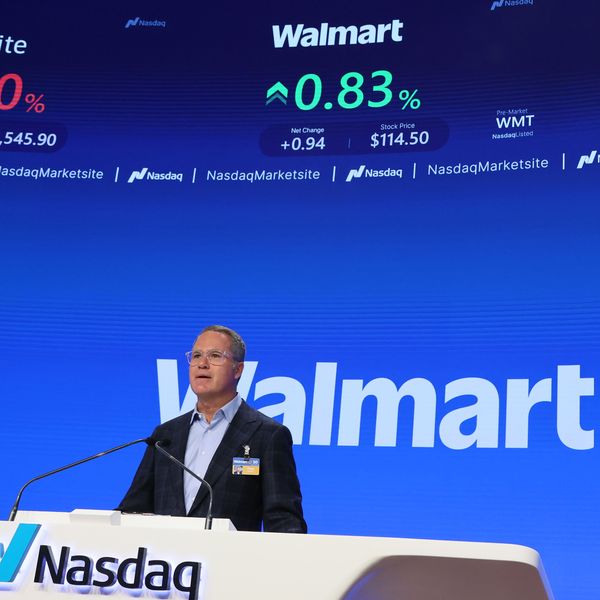
Amazon delivery drivers and dispatchers strike at the company's Palmdale, California warehouse and delivery center on July 25, 2023.
'Groundbreaking' Win as NLRB Rules Amazon Must Bargain With Delivery Drivers
"Despite wielding absolute control over the drivers' terms and conditions of employment," said the International Brotherhood of Teamsters, "Amazon maintained that it did not employ the workers."
A decision by the National Labor Relations Board on Thursday marked "the beginning of the end for Amazon's favorite legal loophole," said one grassroots labor group, as the board ruled that Amazon is a joint employer of its drivers—making it legally required to recognize and bargain with the International Brotherhood of Teamsters union that represents dozens of the delivery workers.
The NLRB concluded its investigation that began more than a year ago, when 84 Amazon workers at the company's Palmdale, California warehouse joined the Teamsters Local 396 union, negotiating a contract with Amazon's Delivery Service Partner (DSP), a subcontractor which Amazon claimed was the drivers' employer.
"Despite wielding absolute control over the drivers' terms and conditions of employment," said the Teamsters in a statement on Thursday, "Amazon maintained that it did not employ the workers and refused to recognize or negotiate with the Teamsters."
Through its investigation, the NLRB found Amazon had unlawfully refused to recognize the workers' decision to unionize, threatened employees with job loss, held illegal captive audience meetings where managers spread anti-union misinformation, and intimidated workers.
The NLRB is expected to prosecute Amazon "before an NLRB judge for its serious and callous violations of workers' rights."
The ruling comes less than a year after the NLRB finalized its joint-employer rule, establishing that two or more entities can be considered joint employers of a group of employees if they both have employment relationship with the workers and help to determine their terms and conditions of employment.
That ruling and the decision announced on Thursday, said the Teamsters, "shatters [the] myth" that Amazon is not the Palmdale workers' employer even as it "exercises widespread control over drivers' labor and working conditions."
One driver called the decision a "groundbreaking ruling."
"Amazon is our joint employer," he said in a video posted to social media. "Why? Because the whole world knows who our true employer is... We wear their colors, drive their vans, and yet, we're not their employees? How does that make sense?"
With the ruling, said Athena, a grassroots coalition of Amazon workers, the NLRB has told the company that "it can't game the system anymore when its comes to drivers."
"Lots of Amazon's wealth was build by gaming tax laws, employment laws, public subsidies, lax privacy laws, unenforced antitrust laws, etc.—we all let it go on too long, but not anymore," said the group.
An Urgent Message From Our Co-Founder
Dear Common Dreams reader, The U.S. is on a fast track to authoritarianism like nothing I've ever seen. Meanwhile, corporate news outlets are utterly capitulating to Trump, twisting their coverage to avoid drawing his ire while lining up to stuff cash in his pockets. That's why I believe that Common Dreams is doing the best and most consequential reporting that we've ever done. Our small but mighty team is a progressive reporting powerhouse, covering the news every day that the corporate media never will. Our mission has always been simple: To inform. To inspire. And to ignite change for the common good. Now here's the key piece that I want all our readers to understand: None of this would be possible without your financial support. That's not just some fundraising cliche. It's the absolute and literal truth. We don't accept corporate advertising and never will. We don't have a paywall because we don't think people should be blocked from critical news based on their ability to pay. Everything we do is funded by the donations of readers like you. Will you donate now to help power the nonprofit, independent reporting of Common Dreams? Thank you for being a vital member of our community. Together, we can keep independent journalism alive when it’s needed most. - Craig Brown, Co-founder |
A decision by the National Labor Relations Board on Thursday marked "the beginning of the end for Amazon's favorite legal loophole," said one grassroots labor group, as the board ruled that Amazon is a joint employer of its drivers—making it legally required to recognize and bargain with the International Brotherhood of Teamsters union that represents dozens of the delivery workers.
The NLRB concluded its investigation that began more than a year ago, when 84 Amazon workers at the company's Palmdale, California warehouse joined the Teamsters Local 396 union, negotiating a contract with Amazon's Delivery Service Partner (DSP), a subcontractor which Amazon claimed was the drivers' employer.
"Despite wielding absolute control over the drivers' terms and conditions of employment," said the Teamsters in a statement on Thursday, "Amazon maintained that it did not employ the workers and refused to recognize or negotiate with the Teamsters."
Through its investigation, the NLRB found Amazon had unlawfully refused to recognize the workers' decision to unionize, threatened employees with job loss, held illegal captive audience meetings where managers spread anti-union misinformation, and intimidated workers.
The NLRB is expected to prosecute Amazon "before an NLRB judge for its serious and callous violations of workers' rights."
The ruling comes less than a year after the NLRB finalized its joint-employer rule, establishing that two or more entities can be considered joint employers of a group of employees if they both have employment relationship with the workers and help to determine their terms and conditions of employment.
That ruling and the decision announced on Thursday, said the Teamsters, "shatters [the] myth" that Amazon is not the Palmdale workers' employer even as it "exercises widespread control over drivers' labor and working conditions."
One driver called the decision a "groundbreaking ruling."
"Amazon is our joint employer," he said in a video posted to social media. "Why? Because the whole world knows who our true employer is... We wear their colors, drive their vans, and yet, we're not their employees? How does that make sense?"
With the ruling, said Athena, a grassroots coalition of Amazon workers, the NLRB has told the company that "it can't game the system anymore when its comes to drivers."
"Lots of Amazon's wealth was build by gaming tax laws, employment laws, public subsidies, lax privacy laws, unenforced antitrust laws, etc.—we all let it go on too long, but not anymore," said the group.
- Workers, Businesses Show Support for Striking Frito-Lay Workers in Kansas ›
- 'When We Fight, We Win!': LA School Workers Secure Deal After 3-Day Strike ›
- 'Biggest Ever Global Strike Against Amazon' Kicks Off on Black Friday ›
- With NLRB Complaint, Amazon Drivers 'One Step Closer' to Conditions They Deserve | Common Dreams ›
- 'Tired of Amazon's Lies,' California Teamsters Join Strike Threat | Common Dreams ›
A decision by the National Labor Relations Board on Thursday marked "the beginning of the end for Amazon's favorite legal loophole," said one grassroots labor group, as the board ruled that Amazon is a joint employer of its drivers—making it legally required to recognize and bargain with the International Brotherhood of Teamsters union that represents dozens of the delivery workers.
The NLRB concluded its investigation that began more than a year ago, when 84 Amazon workers at the company's Palmdale, California warehouse joined the Teamsters Local 396 union, negotiating a contract with Amazon's Delivery Service Partner (DSP), a subcontractor which Amazon claimed was the drivers' employer.
"Despite wielding absolute control over the drivers' terms and conditions of employment," said the Teamsters in a statement on Thursday, "Amazon maintained that it did not employ the workers and refused to recognize or negotiate with the Teamsters."
Through its investigation, the NLRB found Amazon had unlawfully refused to recognize the workers' decision to unionize, threatened employees with job loss, held illegal captive audience meetings where managers spread anti-union misinformation, and intimidated workers.
The NLRB is expected to prosecute Amazon "before an NLRB judge for its serious and callous violations of workers' rights."
The ruling comes less than a year after the NLRB finalized its joint-employer rule, establishing that two or more entities can be considered joint employers of a group of employees if they both have employment relationship with the workers and help to determine their terms and conditions of employment.
That ruling and the decision announced on Thursday, said the Teamsters, "shatters [the] myth" that Amazon is not the Palmdale workers' employer even as it "exercises widespread control over drivers' labor and working conditions."
One driver called the decision a "groundbreaking ruling."
"Amazon is our joint employer," he said in a video posted to social media. "Why? Because the whole world knows who our true employer is... We wear their colors, drive their vans, and yet, we're not their employees? How does that make sense?"
With the ruling, said Athena, a grassroots coalition of Amazon workers, the NLRB has told the company that "it can't game the system anymore when its comes to drivers."
"Lots of Amazon's wealth was build by gaming tax laws, employment laws, public subsidies, lax privacy laws, unenforced antitrust laws, etc.—we all let it go on too long, but not anymore," said the group.
- Workers, Businesses Show Support for Striking Frito-Lay Workers in Kansas ›
- 'When We Fight, We Win!': LA School Workers Secure Deal After 3-Day Strike ›
- 'Biggest Ever Global Strike Against Amazon' Kicks Off on Black Friday ›
- With NLRB Complaint, Amazon Drivers 'One Step Closer' to Conditions They Deserve | Common Dreams ›
- 'Tired of Amazon's Lies,' California Teamsters Join Strike Threat | Common Dreams ›

